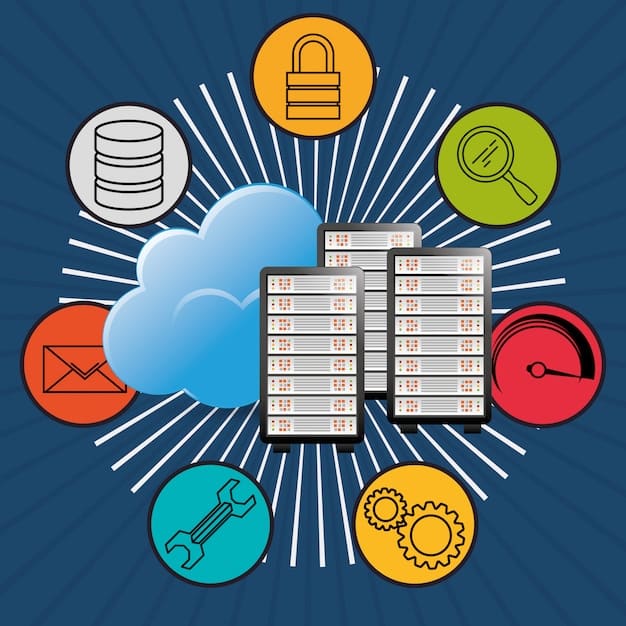Data Privacy Updates: Are Your Personal Details Safe?

Data privacy is an ongoing concern, and recent updates from major tech companies aim to address this by providing users with more control over their personal information and how it’s used.
In today’s digital age, the question, “**Is Your Data Safe? Understanding the Latest Privacy Updates from Major Tech Companies**”, is more relevant than ever. With countless interactions happening online every day, understanding how tech giants are handling user data and privacy is crucial for both individuals and businesses alike.
Understanding the Evolving Data Privacy Landscape
The world of data privacy is constantly changing as technology advances and new regulations emerge. It’s crucial to stay informed about these developments to protect your personal information effectively. This section will explore the key factors shaping the current data privacy landscape.
Understanding the latest privacy updates from major tech companies requires staying abreast of evolving regulations and technological advancements. Let us delve into the transformative forces reshaping data protection, including the impact of GDPR, CCPA, and emerging privacy-enhancing technologies.
The Impact of GDPR and CCPA
The General Data Protection Regulation (GDPR) and the California Consumer Privacy Act (CCPA) have set new standards for data privacy rights and corporate responsibilities. These regulations empower users with greater control over their personal data and impose strict requirements on organizations that collect and process it.
The introduction of the GDPR in Europe marked a significant milestone, while the CCPA in California offered similar protections to its residents, establishing significant milestones in consumer data protection. These landmark legislations have broad implications for businesses worldwide, underscoring the importance of compliance and transparency.
- GDPR’s Focus: The GDPR emphasizes consent, transparency, and the right to be forgotten, impacting businesses globally that handle EU citizens’ data.
- CCPA’s Consumer Rights: The CCPA grants California residents the right to know, delete, and opt-out of the sale of their personal information.
- Global Influence: GDPR and CCPA have inspired similar legislation in other countries and states, creating a fragmented but stronger global privacy framework.

In conclusion, these regulations have not only reshaped the legal landscape but have also influenced corporate practices, driving businesses to adopt more privacy-centric approaches.
Apple’s Privacy-Focused Features
Apple has long positioned itself as a champion of user privacy, implementing various features to protect user data. These features are designed to give users more control over their information and limit tracking by third parties. This section will delve into Apple’s most prominent privacy enhancements.
Apple has increasingly focused on user privacy, integrating robust features into its operating systems and devices. Let us examine how Apple is prioritizing data protection, exploring its innovative privacy features and how they impact the user experience.
App Tracking Transparency (ATT)
Apple’s App Tracking Transparency (ATT) feature requires apps to obtain user consent before tracking their activity across other apps and websites. This has significantly impacted the advertising industry and given users more choice over their data.
Launched with iOS 14.5, ATT fundamentally changed how apps track users for advertising purposes. By requiring apps to obtain explicit consent, Apple has empowered users to control whether their data is shared across different platforms, leading to significant changes in the digital advertising ecosystem.
- User Control: ATT puts users in control, allowing them to choose whether or not to allow tracking on an app-by-app basis.
- Impact on Advertisers: The ad industry has seen significant changes as many users opt-out of tracking, affecting ad revenue and targeting strategies.
- Long-Term Effects: The long-term effects of ATT are still unfolding, but it has certainly set a new standard for user privacy on mobile devices.
To conclude, ATT has become a defining feature of Apple’s commitment to privacy, altering the dynamics between users, apps, and advertisers in the digital landscape.
Google’s Evolving Privacy Initiatives
Google, while often criticized for its data collection practices, has also introduced several privacy initiatives to address user concerns. These initiatives aim to provide users with more transparency and control over their data within the Google ecosystem. This section will examine Google’s efforts to enhance user privacy.
Google has been balancing data collection with user privacy through various initiatives and policy updates. This section will explore Google’s ongoing efforts to enhance data protection, examining recent changes and their implications for users and advertisers.
Privacy Sandbox
Google’s Privacy Sandbox is an initiative to develop new technologies that protect people’s privacy online while still enabling publishers and advertisers to reach their audiences. It aims to replace third-party cookies with more privacy-friendly alternatives.
The Privacy Sandbox is a multifaceted effort to replace third-party cookies with privacy-preserving technologies. This initiative strives to strike a balance between enabling effective advertising and safeguarding user privacy. Let’s take a look at its key principles and technological solutions.
- Replacing Third-Party Cookies: The Privacy Sandbox seeks to eliminate the need for third-party cookies by introducing alternative methods for ad targeting.
- Privacy-Preserving Technologies: These technologies include Federated Learning of Cohorts (FLoC) and other privacy-enhancing techniques.
- Industry Collaboration: Google is collaborating with industry stakeholders to develop and implement these new standards.
To sum up, Privacy Sandbox represents a forward-looking approach to online advertising, aimed at fostering a more privacy-respecting ecosystem while still supporting publishers and advertisers.
Microsoft’s Approach to Data Privacy
Microsoft has also been proactive in implementing data privacy measures, particularly in its cloud services and Windows operating system. These measures are designed to comply with global regulations and provide users with transparency and control over their data. This section will look into Microsoft’s privacy strategies.
Microsoft has emphasized data privacy as a core principle, incorporating advanced features into its products and services. In this regard. let us analyze the privacy enhancements Microsoft has implemented, with a focus on its cloud services and Windows operating system.
Data Encryption and Control
Microsoft employs robust data encryption techniques to protect user data both in transit and at rest. Additionally, Microsoft provides users with tools to manage their data and control who has access to it.
Microsoft has made significant strides in data encryption and access control, providing its users with comprehensive security measures. By encrypting data both in transit and at rest, Microsoft ensures confidentiality. Also, it provides robust tools for users to manage their data and control who can access it, enhancing user autonomy and security.
Additionally, Microsoft’s privacy dashboard allows users to view and manage their data across Microsoft services and offers transparency and control.
- Data Encryption: Microsoft uses advanced encryption algorithms to protect data from unauthorized access.
- Access Control Tools: These tools allow users to manage who can access their data and set privacy preferences.
- Compliance with Regulations: Microsoft adheres to global data privacy regulations, ensuring compliance and accountability.
In the end, Microsoft’s commitment to data encryption and control demonstrates its dedication to protecting user privacy and fostering trust in its services.

Practical Steps to Protect Your Data
While tech companies are taking steps to enhance data privacy, individuals can also take proactive measures to protect their personal information. These steps can range from adjusting privacy settings to using privacy-focused tools. This section will help you outline practical steps for protecting your data.
Individuals can take proactive steps to safeguard their data and minimize privacy risks, because understanding privacy settings, using strong passwords, and leveraging privacy-focused tools can enhance security. Let’s delve into the steps users can take to protect their digital footprint.
Reviewing Privacy Settings
Regularly reviewing and adjusting the privacy settings on your social media accounts, email services, and other online platforms is crucial. Ensure that you are only sharing information with the people you trust and limiting access to your data.
Taking the time to understand and customize privacy settings on online platforms is essential. This simple act can greatly reduce the amount of personal information you share, minimizing your digital footprint.
- Social Media: Audit your privacy settings on platforms like Facebook, Instagram, and Twitter to control who sees your posts and information.
- Email Services: Adjust settings in Gmail, Outlook, or other email providers to manage data sharing and ad personalization.
- App Permissions: Review app permissions on your smartphone to limit access to your location, contacts, and other sensitive information.
Overall, routinely checking and adjusting privacy settings is a simple yet effective way to protect your data and maintain control over your privacy.
Looking Ahead: The Future of Data Privacy
Data privacy will likely remain a central focus for tech companies, regulators, and users in the years to come. Emerging technologies and evolving regulations will continue to shape the data privacy landscape. This section will predict the future path of data privacy.
Data privacy will undergo further transformation with technological advancements and regulatory changes. Here we explore the anticipated trends and developments that will shape the landscape of data privacy, emphasizing artificial intelligence, blockchain, and privacy-enhancing computing.
Emerging Technologies and Regulations
New technologies like artificial intelligence (AI) and blockchain offer both opportunities and challenges for data privacy. As AI becomes more prevalent, ensuring that AI systems handle data ethically and responsibly will be crucial.
Emerging technologies such as AI and blockchain have the potential to transform how data is handled, offering both opportunities and challenges as well. Navigating these advancements requires a proactive and adaptive approach to ensure data privacy is upheld.
- Artificial Intelligence: Ensuring AI systems handle data ethically and responsibly is crucial as AI becomes more pervasive.
- Blockchain Technology: Exploring the potential of blockchain for secure data storage and privacy-preserving transactions.
- Evolving Regulations: Anticipating how new regulations will address emerging technologies and data privacy concerns.
Ultimately, staying ahead of these trends will be essential for navigating the evolving data privacy landscape and ensuring that user data is protected.
| Key Point | Brief Description |
|---|---|
| 🛡️ GDPR and CCPA | Landmark data protection laws empowering users. |
| 🍎 Apple’s ATT | Requires apps to get user consent for tracking. |
| ⚙️ Google’s Privacy Sandbox | Aimed at replacing third-party cookies with privacy-friendly solutions. |
| 🔑 Data Encryption | Protect data with encryption to prevent unauthorized access. |
Frequently Asked Questions
▼
GDPR stands for General Data Protection Regulation. It is a European Union law that regulates data protection and privacy for all individuals within the EU and the European Economic Area.
▼
ATT ia an Apple feature that requires apps to get user permission before tracking their activity across other companies’ apps and websites. Its goal is to give users more choice over their data.
▼
Google’s Privacy Sandbox is an initiative to create new web technologies that protect people’s privacy online and give publishers and advertisers tools to succeed while respecting the user’s privacy.
▼
Microsoft uses encryption techniques to protect user data. They also provide users with tools to manage their data, compliance with global data privacy is available, and they provide access control tools.
▼
You can protect your data by reviewing privacy settings on social media, email services, and apps. Use strong, unique passwords, and consider using privacy-focused tools like VPNs and encrypted messaging apps.
Conclusion
Staying informed about the latest privacy updates from major tech companies is essential for protecting your personal information in the digital age. By understanding the measures being taken by these companies and adopting proactive privacy practices, you can navigate the online world with greater confidence and security.





